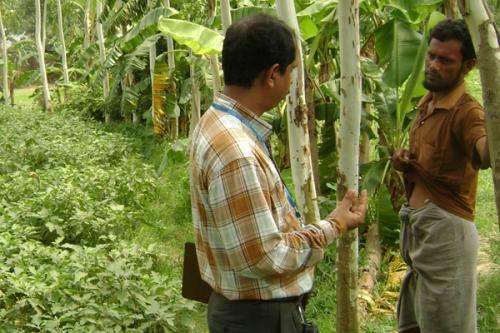Stanford researchers track a silent killer in rural Bangladesh

It's been decades since the U.S. phased out the use of lead in gasoline, paint, pipes and other products because of the metal's insidious health effects. Although lead from previous years' exhaust still persists in soil and dust, Americans have largely rid themselves of the toxin, linked to symptoms ranging from anemia and hearing loss to heart disease and mental retardation. In other parts of the world, however, the specter of lead poisoning still hovers.
An interdisciplinary team of researchers supported by the Stanford Woods Institute for the Environment's Environmental Venture Projects (EVP) seed-grant program is challenging conventional wisdom about why lead contamination lingers in one of the poorest corners of the world. Their work could lead to more rapid testing for contamination, greater public awareness and decisive regulatory action.
In some areas of Bangladesh, as many as half of the residents have high levels of lead in their blood. "If you had children or pregnant women in the U.S. with these levels, there would be an uproar," said Stephen Luby, a Stanford professor of medicine and senior fellow at the Stanford Woods Institute and the Freeman Spogli Institute for International Studies.
With his fellow project investigators, Luby is searching for the dangerous metal's pathways to people and ways to disrupt the status quo.
Decades of research
Luby first started thinking about lead in the developing world when he conducted a study in Pakistan during the early 1990s. The results showed high levels of lead in children's blood, likely a result of the country's continued use of leaded fuel.
After Pakistan banned leaded gas, due in part to the study's influence, Luby shifted his focus to nearby Bangladesh. He came across studies showing lead contamination in the land of two rural areas. "That struck me as odd," Luby recalls. There were few roads and almost no vehicles spewing leaded gas exhaust in the areas. Based on the evidence of higher lead levels in farm land compared with levels in nearby homes, Luby speculated that the contamination was coming from an agricultural product, possibly pesticide, and being absorbed by plants.
A similar story played out in the U.S. apple industry during the late 19th century and early 20th century when the use of lead arsenate pesticides contributed to the contamination of thousands of acres and sickened many field workers.
When he floated his hypothesis to other experts in the field, Luby was met with skepticism. Responding to an email from Luby, one wrote that he was "perplexed" by the idea, while another scientist wrote he "would be very surprised" if Luby's theory proved correct. "They thought I was crazy," Luby said. "It was pretty direct and troubling because it came from people who have been in Bangladesh a long time."
Despite the doubts, Luby pushed on. With colleagues, he collected hundreds of blood samples from residents of agricultural areas. Luby didn't have the funding, however, to test the samples for lead, carry out surveys and do other related work. "Then EVP came along," Luby said. With the program's support, Luby and his fellow project investigators, Assistant Professor of Economics Pascaline Dupas and Woods senior fellows Scott Fendorf (Earth sciences) and Roz Naylor (Earth sciences, FSI), plan to look for lead in blood and soil samples, examine evidence of past contamination and develop ways to test pesticides for the dangerous metal.
Interdisciplinary team of researchers
Naylor's interest in the project was driven by a desire to learn more about Bangladesh's agriculture sector, and how the use of lead-based pesticides potentially acts as a barrier to escaping poverty. "How can a country hope to alleviate rural poverty if people in those areas are cognitively impaired (from lead poisoning)?" Naylor said.
Fendorf, a soil scientist, will focus on how to find lead in soils and how to analyze it. Naylor, an agricultural economist and director of the Center for Food Security and the Environment, will examine market mechanisms for use and overuse of pesticides, among other analyses. Dupas, a developmental economist and center fellow at the Stanford Institute for Economic Policy
Research, will explore behaviors around pesticide use and how to change them. "They will frame issues and ask questions in ways that I wouldn't know to do," Luby said of his colleagues on the project.
Initial testing of samples has confirmed high levels of lead among residents of rural Bangladesh who have very little access to motor vehicles.
Luby hopes that once the pathway of lead contamination is confirmed, future lead identification data in Bangladesh will be published by watchdog groups and garner widespread attention. "We are set up to be able to demonstrate how these rural residents become exposed to such high levels of lead," Luby said. He acknowledges, however, that it may require more to get the attention of powerful decision makers. "If rice for city people is also contaminated, we will have the attention of the political class."


















